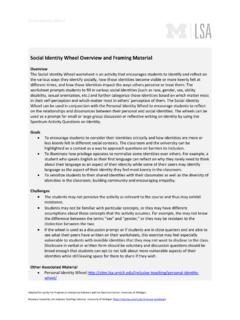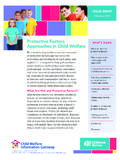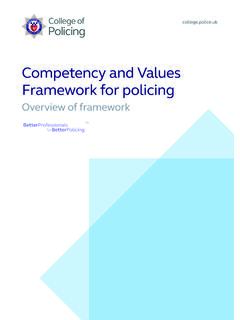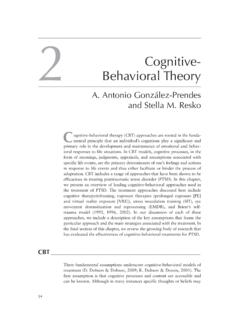Transcription of An Introduction to Content Warnings and Trigger Warnings
1 An Introduction to Content Warnings and Trigger Warnings Overview The following Content and linked resources are a primer to understanding Content Warnings (sometimes called Content notices or Trigger Warnings ). This guide explains what Content and Trigger Warnings are, why they are important to include for inclusive classrooms, and how instructors can implement them. While there has been much debate over the implementation of Content Warnings in the classroom, the debate stems primarily from a misunderstanding regarding what Content Warnings are, how their use can make a classroom more inclusive for students with mental health disabilities, and how they do or don t impact instructor liability.
2 Some of the links provided in this resource include more information on these debates. Potentially unfamiliar vocabulary is in bold text. Goals 1)To explain what Content and Trigger Warnings )To encourage recognition of the importance of the mental and emotional wellbeing )To clarify the value of Content and Trigger Warnings and how they contribute toinclusive )To offer various ways to implement Content and Trigger Warnings in your These resources are best reviewed before the planning phase of course design, so the instructor has ample time to consider how they will implement Content Warnings in addition to working through any discomfort they may have in advance and reviewing their course Content with common triggers in mind.
3 Challenges 1)Until you develop a sensitization for common triggers, it is easy to forget that theyoccur and where they occur in your course )Many feel defensive and resistant to the inclusion of Content Warnings , feeling asthough they put restrictions on the instructor and coddles the inclusion of Content Warnings is neither restrictive (it does not labelanything as off-limits to teach) nor coddling ( it does not assume that studentscannot handle the material, on the contrary, it treats them as adults who canand should attend to their own wellbeing with all available information. An Introduction to Content Warnings and Trigger Warnings in the Classroom What are they? Content Warnings are verbal or written notices that precede potentially sensitive Content .
4 These notices flag the contents of the material that follows, so readers, listeners, or viewers can prepare themselves to adequately engage or, if necessary, disengage for their own wellbeing. The following Content Warnings are the most common. Consider what material covered in your course may include these and how you would like to flag them for your students. Students may request additional tags, as this list is not exhaustive: Sexual assault Abuse Child abuse/pedophilia/incest Animal cruelty or animal death Self-harm and suicide Eating disorders, body hatred, and fat phobia Violence Pornographic Content Kidnapping and abduction Death or dying Pregnancy/childbirth Miscarriages/abortion Blood Mental illness and ableism Racism and racial slurs Sexism and misogyny Classism Hateful language direct at religious groups ( , Islamophobia, anti-Semitism)
5 Transphobia and trans misogyny Homophobia and heterosexism Trigger Warnings are a specific variety of Content Warnings that attempt to forewarn audiences of Content that may cause intense physiological and psychological symptoms for people with Post Traumatic Stress Disorder (PTSD) and other anxiety disorders. PTSD and other anxiety disorders are real mental health disabilities that have physical, emotional, and mental symptoms that are triggered by stimuli that recall an individual s experience of trauma. Individuals do not have control over what triggers them, but many have personal strategies they use to cope with triggers when they must be encountered. o Those strategies generally work best when the Trigger is expected and can be prepared for in advance of the encounter.
6 Hence the importance of Content or Trigger Warnings : they give people the forewarning necessary for them to make use of the strategies that will decrease the harmfulness of encountering triggering material. Content and Trigger Warnings in Your Classroom In the context of the classroom, Content Warnings might be provided on the syllabus, spoken verbally in lectures, sent out as emails, or posted on a class website. They might include forewarnings of challenging moments in texts they will read for class, material that will be covered in lecture, videos viewed in class, and topics that the instructor expects will come up in class discussion (read the section below on implementing Content Warnings for more on this).
7 Content Warnings and Trigger Warnings are not intended to censure instructors nor invite students to avoid material that challenges them. On the contrary, warning students of challenging material can help their engagement by giving them the ability to take charge of their own health and learning. When presented with a scene that depicts sexual violence, a student who was assaulted might shut down, disassociate, panic, become angry, or otherwise disengage from the class as they put all their attention into managing the emotional and physical symptoms the triggering material brings up for them. However, if the student is forewarned that the material includes a depiction of sexual violence, they might prepare for it by meditating, seeing their therapist, or simply give themselves more time to work through the material so they can process it under controlled conditions.
8 Or they might still need to disengage and skip the pages that include the depiction or step out of class for a few minutes when the material is being discussed because their mental health and safety are more important than their engagement with the material. While it is impossible to account for all potential triggers, which could include smells or sounds that recall a past trauma, some of the most common triggers include representations of sexual violence, oppressive language, gunshots, and representations of self-harm. If you establish sufficient trust with your students and make clear to them that you will do your best to supply any requested Trigger Warnings , you can provide personalized notices about any material that may be triggering for them.
9 However, trust can be challenging to build and takes time, so the inclusion of Warnings for common triggers can be helpful to students who may not feel comfortable telling an instructor they barely know very personal information about their mental health and past trauma. The inclusion of common triggers on your syllabus can also help establish trust so students who need Warnings for less common triggers such as specific phobias will recognize that you will take their concerns seriously and without judgment. The motive behind including Content Warnings in classes is based on the simple recognition that our students are people with lives, histories, and struggles that we are not privy to, and cannot always understand.
10 And those lives, histories, and struggles do not stop existing when class starts. Students carry those things with them into class and cannot be expected to turn off their emotions and forget their experiences on a whim, no matter how inconvenient they are to an instructor s designated learning goals. Including Content or Trigger Warnings is an issue of accessibility, as having panic attacks in class (a common outcome when a Trigger is unexpectedly encountered) can prevent a student from learning and adversely impacts their health and wellbeing. The use of Content or Trigger Warnings is not babying or coddling students as some critics suggest; it s the recognition that the inclusion of people with mental health disabilities matters and shifting the norms of Content presentation to include Content Warnings to better include them is well worth the small effort it costs the instructor to note potentially distressing material.








